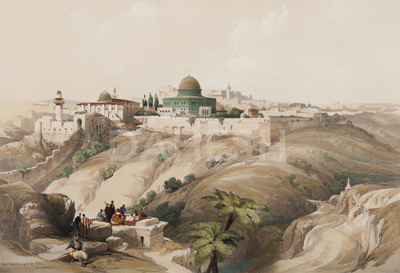After David Roberts, R. A. (British, 1796–1864)
Lithograph by Louis Haghe
Church of the Purification, 1841
Color lithograph, 15 1/4 x 21 in.
Inscribed lower left: David Roberts, April 9, 1839 / Jerusalem; lower center: Church of the Purification / Published by F. G. Moon, 20 Threadneedle St., June 1st, 1841
1995.71

This lithograph, titled Church of the Purification, is one of several views of Jerusalem published by the artist-traveler in The Holy Land, Syria, Idumea, Egypt, & Nubia (1842–49). The artist’s nine-month trip through the Middle East in 1838–39 was inspired by his earlier travels in Spain and Morocco as well as his involvement with T. H. Horne’s Landscape Illustrations of the Bible (1836). In Roberts’ Church of the Purification, the prominent structure at the far left of the scene is the silver-domed Al-Aqsa Mosque (the third holiest site in Islam). The Reverend George Croly—who wrote the text that accompanied Roberts’ prints in the Holy Land publication—believed that this Islamic structure had replaced the Byzantine Church of the Purification, which had been commissioned by the Emperor Justinian in the 6th century. Archaeological evidence, however, indicates that this famous church was actually in another quarter of the city and not on the Temple Mount. The Church of the Purification is, in fact, not represented in this westward view of the Jerusalem landscape. What Roberts does depict in Church of the Purification, however, in addition to the Al-Aqsa Mosque, is the famous Western (or Wailing) Wall (one of the most sacred sites in Judaism) and the renowned gold-domed Islamic shrine, the Dome of the Rock. Through this scene, Roberts offers a distant view of Temple Mount, one of the most important religious sites in Jerusalem—and one held sacred by Christianity and Judaism as well as Islam.


